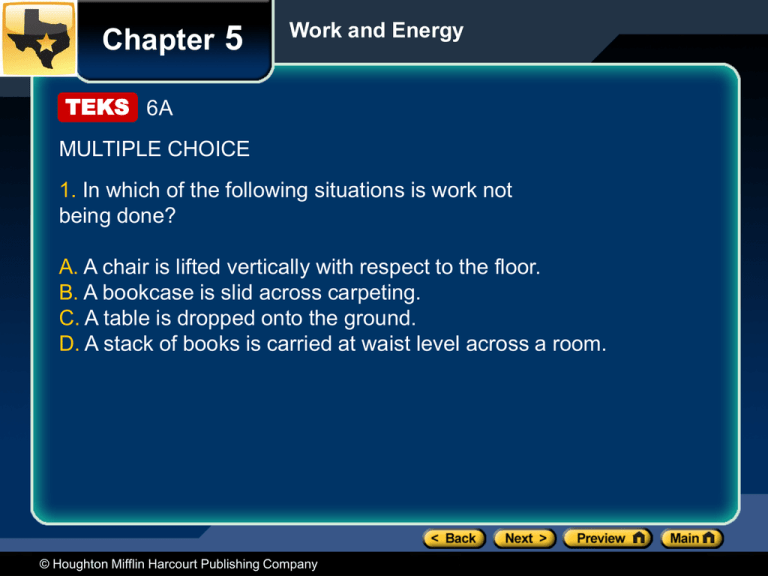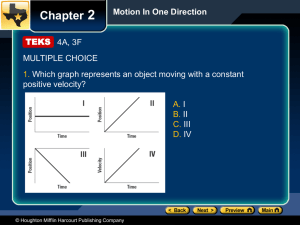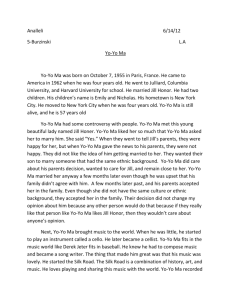TEKS - Sharyland ISD
advertisement

Chapter 5 Work and Energy TEKS 6A MULTIPLE CHOICE 1. In which of the following situations is work not being done? A. A chair is lifted vertically with respect to the floor. B. A bookcase is slid across carpeting. C. A table is dropped onto the ground. D. A stack of books is carried at waist level across a room. © Houghton Mifflin Harcourt Publishing Company Chapter 5 Work and Energy TEKS 6A MULTIPLE CHOICE 1. In which of the following situations is work not being done? A. A chair is lifted vertically with respect to the floor. B. A bookcase is slid across carpeting. C. A table is dropped onto the ground. D. A stack of books is carried at waist level across a room. © Houghton Mifflin Harcourt Publishing Company Chapter 5 Work and Energy TEKS 6C Use the graph to the right to answer questions 2–4. The graph shows the energy of a 75 g yo-yo at different times as the yo-yo moves up and down on its string. 2. By what amount does the mechanical energy of the yo-yo change after 6.0 s? A. 500 mJ B. 0 mJ C. -100 mJ D. -600 mJ © Houghton Mifflin Harcourt Publishing Company Chapter 5 Work and Energy TEKS 6C Use the graph to the right to answer questions 2–4. The graph shows the energy of a 75 g yo-yo at different times as the yo-yo moves up and down on its string. 2. By what amount does the mechanical energy of the yo-yo change after 6.0 s? A. 500 mJ B. 0 mJ C. -100 mJ D. -600 mJ © Houghton Mifflin Harcourt Publishing Company Chapter 5 Work and Energy TEKS 6D Use the graph to the right to answer questions 2–4. The graph shows the energy of a 75 g yo-yo at different times as the yo-yo moves up and down on its string. 3. What is the speed of the yo-yo after 4.5 s? A. 3.1 m/s B. 2.3 m/s C. 3.6 m/s D. 1.6 m/s © Houghton Mifflin Harcourt Publishing Company Chapter 5 Work and Energy TEKS 6D Use the graph to the right to answer questions 2–4. The graph shows the energy of a 75 g yo-yo at different times as the yo-yo moves up and down on its string. 3. What is the speed of the yo-yo after 4.5 s? A. 3.1 m/s B. 2.3 m/s C. 3.6 m/s D. 1.6 m/s © Houghton Mifflin Harcourt Publishing Company Chapter 5 Work and Energy TEKS 6B Use the graph to the right to answer questions 2–4. The graph shows the energy of a 75 g yo-yo at different times as the yo-yo moves up and down on its string. 4. What is the maximum height of the yo-yo? A. 0.27 m B. 0.54 m C. 0.75 m D. 0.82 m © Houghton Mifflin Harcourt Publishing Company Chapter 5 Work and Energy TEKS 6B Use the graph to the right to answer questions 2–4. The graph shows the energy of a 75 g yo-yo at different times as the yo-yo moves up and down on its string. 4. What is the maximum height of the yo-yo? A. 0.27 m B. 0.54 m C. 0.75 m D. 0.82 m © Houghton Mifflin Harcourt Publishing Company Chapter 5 Work and Energy TEKS 6D 5. A car of mass m requires 5.0 kJ of work to move from rest to a final speed v. If the same amount of work is performed during the same amount of time on a car with a mass of 2m, what is the final speed of the second car? A. B. C. D. © Houghton Mifflin Harcourt Publishing Company Chapter 5 Work and Energy TEKS 6D 5. A car of mass m requires 5.0 kJ of work to move from rest to a final speed v. If the same amount of work is performed during the same amount of time on a car with a mass of 2m, what is the final speed of the second car? A. B. C. D. © Houghton Mifflin Harcourt Publishing Company Chapter 5 Work and Energy TEKS 6C 6. A 70.0 kg base runner moving at a speed of 4.0 m/s begins his slide into second base. The coefficient of friction between his clothes and Earth is 0.70. His slide lowers his speed to zero just as he reaches the base. How much mechanical energy is lost because of friction acting on the runner? A. 1100 J B. 560 J C. 140 J D. 0 J © Houghton Mifflin Harcourt Publishing Company Chapter 5 Work and Energy TEKS 6C 6. A 70.0 kg base runner moving at a speed of 4.0 m/s begins his slide into second base. The coefficient of friction between his clothes and Earth is 0.70. His slide lowers his speed to zero just as he reaches the base. How much mechanical energy is lost because of friction acting on the runner? A. 1100 J B. 560 J C. 140 J D. 0 J © Houghton Mifflin Harcourt Publishing Company Chapter 5 Work and Energy TEKS 6B, 3F 7. A spring scale has a spring with a force constant of 250 N/m and a weighing pan with a mass of 0.075 kg. During one weighing, the spring is stretched a distance of 12 cm from equilibrium. During a second weighing, the spring is stretched a distance of 18 cm. How many times greater is the elastic potential energy of the stretched spring during the second weighing than during the first weighing? A. 9/4 B. 3/2 C. 2/3 D. 4/9 © Houghton Mifflin Harcourt Publishing Company Chapter 5 Work and Energy TEKS 6B, 3F 7. A spring scale has a spring with a force constant of 250 N/m and a weighing pan with a mass of 0.075 kg. During one weighing, the spring is stretched a distance of 12 cm from equilibrium. During a second weighing, the spring is stretched a distance of 18 cm. How many times greater is the elastic potential energy of the stretched spring during the second weighing than during the first weighing? A. 9/4 B. 3/2 C. 2/3 D. 4/9 © Houghton Mifflin Harcourt Publishing Company Chapter 5 Work and Energy TEKS 6C GRIDDED RESPONSE 8. A student with a mass of 66.0 kg climbs a staircase in 44.0 s. If the distance between the base and the top if the staircase is 14.0 m, how much power, in watts, will the student deliver by climbing the stairs? © Houghton Mifflin Harcourt Publishing Company Chapter 5 Work and Energy TEKS 6C GRIDDED RESPONSE 8. A student with a mass of 66.0 kg climbs a staircase in 44.0 s. If the distance between the base and the top if the staircase is 14.0 m, how much power, in watts, will the student deliver by climbing the stairs? = +206 © Houghton Mifflin Harcourt Publishing Company









